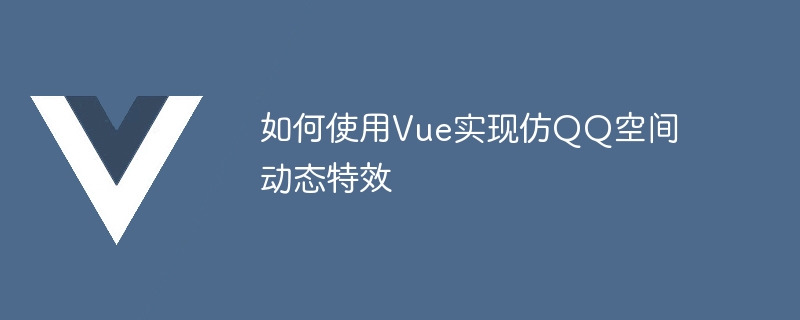

How to use Vue to implement QQ space-like dynamic special effects
Introduction:
With the development of social media, users’ demand for personal homepages is also getting higher and higher. . As one of the major platforms, QQ Zone’s unique dynamic effects are an important factor in attracting users. This article will introduce how to use the Vue framework to implement QQ space-like dynamic special effects and provide specific code examples.
1. Create a project:
First, we need to create a project based on Vue. You can use Vue CLI to quickly create a new project, open a terminal, and run the following command:
vue create qq-space cd qq-space
This will create a project named qq-space and enter the project directory.
2. Introduce necessary libraries:
In order to achieve dynamic special effects imitating QQ space, we need to introduce some necessary libraries. These libraries can be installed via npm by running the following command:
npm install animate.css npm install vue-feather-icons
animate.css is a CSS library for adding animation effects, while vue-feather-icons Provides a series of beautiful icons that we can use in dynamic effects.
3. Create a component:
Next we create a component named DynamicPost and create DynamicPost in the src/components directory of the project .vue file, and introduce the component in the App.vue file.
In DynamicPost.vue, we can write the structure and style of the component using the following code:
<template>
<div class="dynamic-post">
<div class="post-header">
<img class="avatar" :src="post.avatar" alt="avatar">
<div class="username">{{ post.username }}</div>
</div>
<div class="post-content">{{ post.content }}</div>
<div class="post-actions">
<div class="like-button" @click="likePost">
<icon name="heart" />
{{ post.likes }} Likes
</div>
<div class="comment-button" @click="commentPost">
<icon name="message-square" />
{{ post.comments }} Comments
</div>
</div>
</div>
</template>
<script>
import Icon from "vue-feather-icons";
export default {
components: {
Icon,
},
props: {
post: {
type: Object,
required: true,
},
},
methods: {
likePost() {
// 处理点赞逻辑
},
commentPost() {
// 处理评论逻辑
},
},
};
</script>
<style scoped>
.dynamic-post {
/* 样式省略 */
}
</style>In the above code, we used vue- Icon component in feather-icons library to render icons. The component accepts a props named post for delivering dynamic content. And two simple click event handling methods for simulating like and comment operations.
4. Create animation effects:
Next, we will add animation effects to the component. On the root element in the <template> tag, add the following code:
<transition name="slide-up"> <!-- 组件内容省略 --> </transition>
In the <style> tag, add the following style:
.slide-up-enter-active,
.slide-up-leave-active {
transition: transform 0.5s;
}
.slide-up-enter,
.slide-up-leave-to {
transform: translateY(100%);
}The above code will add a sliding-up animation effect to the component. When the component enters or leaves the page, animation effects will appear.
5. Use dynamic data:
Now we can use the DynamicPost component in App.vue and provide some dynamic data to demonstrate the effect. Within the root element in the <template> tag, add the following code:
<DynamicPost :post="post" />
In the <script> tag, add the following code:
data() {
return {
post: {
avatar: "https://example.com/avatar.png",
username: "John Doe",
content: "This is a dynamic post.",
likes: 10,
comments: 5,
},
};
},The above code will render a DynamicPost component with dynamic content.
6. Run the project:
Now, we have completed the code writing for the dynamic special effects of QQ space. Run the following command to start the development server:
npm run serve
Then visit http://localhost:8080 in the browser, you will see a QQ space imitation containing dynamic special effects.
Conclusion:
This article introduces how to use the Vue framework to implement QQ space-like dynamic special effects, and gives detailed code examples. By using Vue's componentization and animation capabilities, we can easily create beautiful and feature-rich dynamic web page effects. I hope this article will be helpful to developers who want to learn Vue dynamic effects.
The above is the detailed content of How to use Vue to implement QQ space dynamic special effects. For more information, please follow other related articles on the PHP Chinese website!